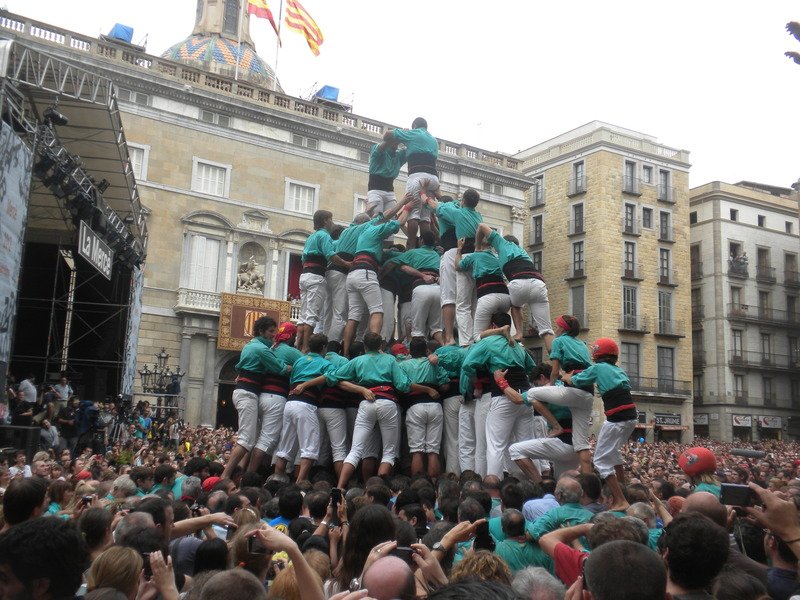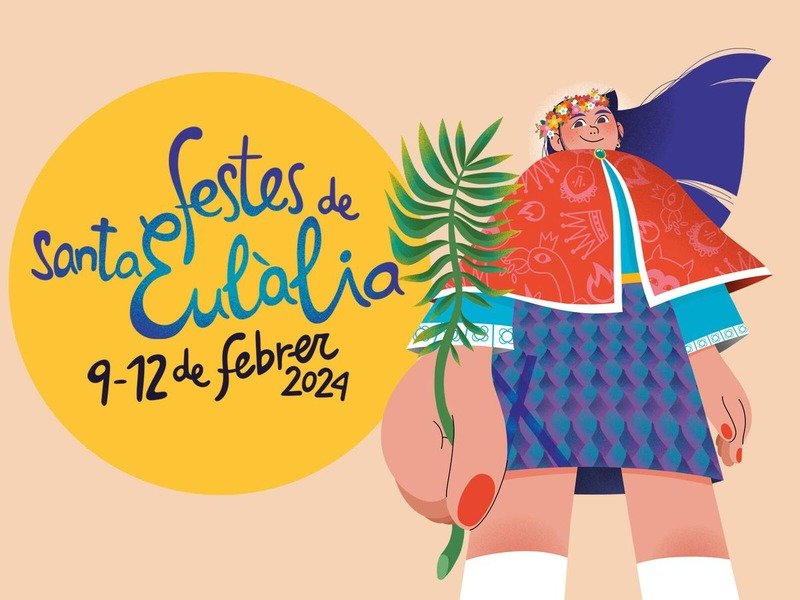The Santa Eulàlia Festivities once again fill the streets of Barcelona with a festive and cultural spirit. From February 9th to 12th, the city celebrates its co-patron saint, offering a great program of activities that range from emblematic parades to concerts and commemorative events. This year, the event gains special relevance as it coincides with the bicentennial of the birth of Josep Anselm Clavé, an iconic figure in Barcelona’s music and journalism.
On Friday, February 9th, at 8:00 p.m., the City’s Eagle will mark the beginning of the festivities departing from the Town Hall. This act will lead to a parade that will end at the basilica of Santa Maria del Mar, where the traditional dance of the Eagle will take place. Throughout Saturday, the streets will be the stage for a lively morning parade featuring giants, big-headed figures, and other typical characters of the festival, culminating with the children’s correfoc (fire run) at 6:30 p.m. and the adult correfoc at 8:00 p.m., starting from Sant Jaume square.

On Sunday, February 11th, Sant Jaume square will transform into a vibrant stage for the traditional human tower building event at 11:30 a.m., an event that brings together the casteller groups of the city. That same day, tribute will be paid to Anselm Clavé with a fusion of choral singing and rock, highlighting the union of Sau 30 with choirs in a special concert in the same square.
Music will continue to be a protagonist during the weekend with the 37th International Folk Festival “Tradicionàrius,” which will descend from Vila de Gràcia to Sant Jaume square, enriching the festivities with folk rhythms and concerts by Glam Folk and La Cosina. Additionally, on Saturday night, Moll de la Fusta will host “Lali Jove,” a celebration aimed at the younger audience that will include the Barna Jove Awards ceremony at 8:00 p.m., followed by performances by Fades, Svetlana, Sexenni, and DJ Trapella.
Regarding dance, on Saturday morning, the Cathedral Avenue will host encounters of “colles bastoneres” (stick dancers) and “sardanes” (traditional Catalan dance), as well as the 19th Exhibition of Children and Youth Dance Groups. The show “Eulàlia,” which pays homage to the life of the saint, will be another highlighted event, reflecting the cultural richness of Catalan tradition.
On Monday, February 12th, the feast of Santa Eulàlia will begin with the banner ceremony at 9:45 a.m. on the Town Hall balcony, followed by the “Paseo de las Laies” and the floral offering. This day will conclude with the Santa Eulàlia dance in the afternoon. Additionally, on Saturday, there will be open days at the Town Hall and various museums in the city, offering Barcelona residents and visitors the opportunity to explore the cultural heritage of Barcelona for free.
Free Museums in Barcelona for Santa Eulàlia
Many of the city’s offer jornada de portes obertes (open doors) for Santa Eulàlia. Please note that because these visits are so popular, a number of locations either require or recommend that you reserve your ticket in advance so you’re not left waiting in long lines or get stuck without a ticket.
Arts Santa Mònica Always free, open Tuesday-Sunday and public holidays, 11:00-20:30.
Arxiu Fotogràfic de Barcelona Always free, Monday-Saturday, 10:00-19:00, Sundays and holidays 10:00-14:00.
Arxiu Històric de la Ciutat de Barcelona Always free, Monday-Friday, 9:00-19:30, Saturday 10:00-19:30.
Barcelona Museum of Contemporary Art (MACBA) Free entry February 11, 2024, 10:00-15:00. Advance booking is recommended.
Biblioteca Pública Arús Free entry February 9, 2024, 10:00-14:30.
Born Centre Cultural Free entry February 11, 2024, 10:00-20:00.
CaixaForum Free entry February 11, 2024, 10:00-20:00. Tickets must be booked in advance on the museum website.
Can Framis Free entry February 11, 2024, 11:00-14:00.
Casa dels Entremesos Free entry February 9-10, 2024, 10:00-13:00 and 16:00-19:00.
Castell de Montjuïc Free entry February 11, 2024, 10:00-18:00.
Centre de Cultura Contemporània de Barcelona (CCCB), Free entry February 11, 2024, 11:00-20:00.
CosmoCaixa Free entry February 11, 2024, 10:00-20:00. Tickets must be booked in advance on the museum website.
Espai Bombers: Parc de la Prevenció Free entry February 11, 2024, 11:00-15:00.
Fabra i Coats Centre d’Art Contemporani Free entry February 11, 2024, 11:00-15:00.
Fundació Antoni Tàpies Free entry February 11, 2024, 10:00-15:00.
Fundació Foto Colectania To be confirmed.
Fundació Joan Brossa. Centre de les Arts Lliures Free entry February 11, 2024, 11:00-18:00.
Fundació Joan Miró Free entry February 11, 2024, 10:00-19:00. Tickets must be booked in advance on the museum website.
Jardí Botànic de Barcelona Free entry February 11, 2024, 10:00-18:00.
La Capella Always free, February 10 & 11, 2024, 12:00-20:00.
La Virreina Centre de la Imatge Always free, February 10 & 11, 2024, 11:00-20:00.
Monestir de Pedralbes Free entry February 11, 2024, 10:00-17:00.
MUHBA Museu d’Història de Barcelona, Plaça del Rei Free entry February 11, 2024, 10:00-20:00.
MUHBA Museu d’Història de Barcelona El Call Free entry February 11, 2024, 11:00-15:00 and 16:00-19:00.
MUHBA Oliva Artés Free entry February 11, 2024, 11:00-15:00 and 16:00-18:00.
MUHBA Temple d’August Always free, Mondays 10:00-14:00; Tuesday-Saturday, 10:00-19:00; Sunday 10:00-20:00.
MUHBA Turó de la Rovira Free entry February 11, 2024, 10:00-15:00.
Museu d’Arqueologia de Catalunya Free entry February 12, 2024, 9:30-14:30.
Museu d’Història de Catalunya Free entry February 11 & 12, 2024, 10:00-14:30.
Museu de Carrosses Fúnebres Always free. There will be a one-hour tour on February 10 & 11, 2024 at 12:00 (in Catalan). Open February 10 & 11, 2024, 10:00-14:00.
Museu de Ciències Naturals Free entry February 11, 2024, 10:00-20:00.
Museu de la Música Free entry February 11, 2024, 10:00-19:00.
Museu del Disseny Free entry February 11, 2024, 10:00-20:00.
Museu Etnològic i Cultures del món (Montcada) Free entry February 11, 2024, 10:00-20:00.
Museu Etnològic i Cultures del món (Montjuïc) Free entry February 11, 2024, 10:00-20:00.
Museu Frederic Marès Free entry February 11, 2024, 11:00-20:00.
Museu Marítim de Barcelona Free entry February 11, 2024, 10:00-20:00.
Museu Nacional d’Art de Catalunya (MNAC) Free entry February 6-11, 2024 for all women named Laia, Eulalia or Olaya (plus a guest). Then, on February 11, 2024 the museum is free to all 10:00-15:00.
Museu Olímpic i de l’Esport Joan Antoni Samaranch Free entry February 11, 2024, 10:00-14:30.
Museu Picasso Free entry February 11, 2024, 10:00-19:00.
Palau Güell Free entry February 11, 2024, 10:00-17:30. Reservation required.
Palau Robert Always free, Open Monday to Saturday 9:00-20:00, Sundays and public holidays 9:00-14:30.
Pavelló Mies van der Rohe Free entry February 11, 2024, 10:00-18:00.



Thank you for reading and sharing stories of art & creativity on FrikiFish! This platform is an ad-free, one-woman labor of love, providing free content and services to artists, art-lovers and creative projects in Barcelona. If these pages enrich your life in any way, please consider supporting with a donation or a cup of coffee. Thank you!